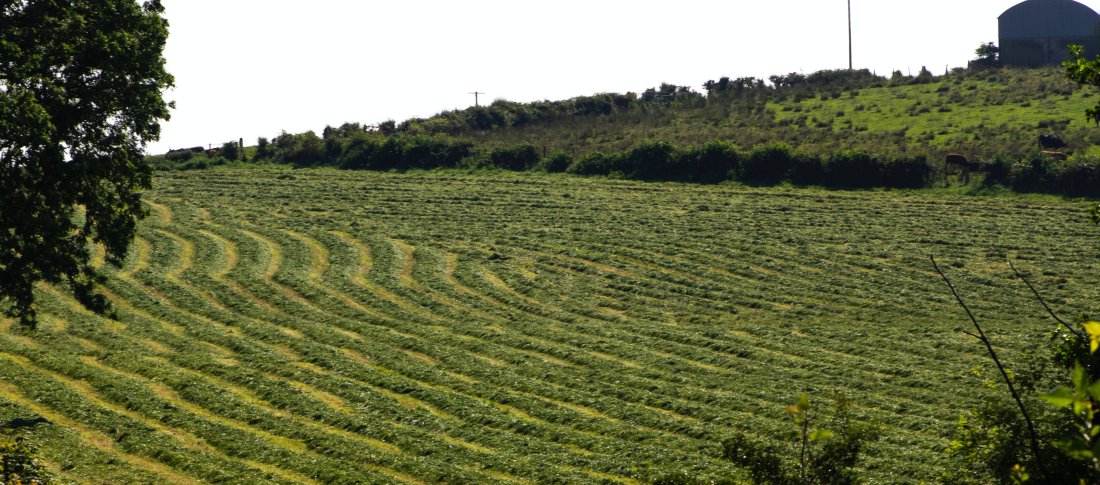The art of making the perfect silage
16 June 2023
Amidst challenging conditions, farmers eagerly anticipate their upcoming yields and understand the significance of producing high-quality silage. However, achieving the desired dry matter target for optimal quality can be a challenge. In this article, we will delve into essential considerations for successful silage making and maintaining its quality throughout the entire silage making process.

The wilting hours
Wilting is a crucial time for seemingly supernatural goings-on relating to the sugar levels in your silage crop. A rapid wilt – with a cut in the morning and harvest later the same day – is likely to result in high sugar levels in the crop compared to a longer wilt. However, if wilting over 24 hours, a late evening cut is advised as there will be a higher sugar content in the grass at this time of day, but more will be lost the longer it is laid wilting.
Wilting wins…
- Spread the cut grass straight out of the mower to help reduce wilting time.
- Monitor dry matter in the field for that optimum 28 – 32%. The less time cut grass is left wilting, the less sugar will be lost.
- Row up immediately before harvest and ensure your machine is set up on a flat surface and not scraping up any soil to contaminate your silage crop.
Chop length V’s clamp health
The old adage that long chop material is essential is something of an old wives tale. In fact, it’s a little more scientific than that, with an impact on overall clamp health.
As a general rule, for a crop with less than 22% dry matter (it’s certainly going this way this year!), a 10cm chop length is recommended to reduce the occurrence of clamp slippage at feed-out. For a crop of 22-25% dry matter, chop length can be reduced to 7.5cm, from 25-30% dry matter, the chop can be further reduced to 2.5 – 5cm, but above 30% dry matter, the chop length should be no greater than 2.5cm.
The exception to this rule is a really good quality silage with high digestibility. In this case, a 5cm chop length is suggested to counter the reduced fibre in the crop and reduce slippage in the clamp.
Consolidate your clamping efforts
Treat your clamp as if it were an airbed you’re trying to pack away after that weekend camping trip. Playing close attention to the loading of your clamp is crucial – unlike packing away your airbed, not purely for the purpose of trying to fit your whole crop in there, but squeezing as much air out of it as you can is vital.
Trapped air = reduced fermentation quality and improved conditions for aerobic instability at feeding.
Clamping top tips
- Create even layers of no more than 15cm thick.
- Compact each layer evenly before adding the next.
- Prioritise your clamping procedure over your harvesting – it’s essential to get this right.
- Seal your clamp like you’re packaging a parcel to send overseas. Minimising oxygen in the clamp is paramount for optimum silage quality.
- Sheet all sides of your clamp, securing the bases with gravel bags to help reduce Oxygen ingress, which will reduce the quality of your fermentation.
- Seal your clamp for a minimum of two months. During this two-month period, the yeast population that is the initiator of aerobic spoilage at feeding is reduced.
Care for your crop doesn’t stop there…
Unlike hay, which generally, once stacked in a dry barn, is pretty safe from spoilage, the care of your silage clamp continues through feed-out.
Keeping the clamp in front of the silage clean enough to eat your dinner from, majorly reduces the risk of compromising the rest of your crop. Dirt and spoiled silage simply provide a breeding ground for unwanted nasties that we really don’t want in our clamps.
Maintaining a straight face is something dairy farmers are well versed at, but when it comes to your silage clamp, it’s top of the list in best practice. A shear grab or defacer is invaluable when feeding out, in order to maintain the minimum exposed surface area and reduced opportunity for oxygen ingress and resulting nutritional losses.
Key take-aways
Aerobic spoilage is the number one issue affecting silage quality globally, a big cause of which is poor clamp compaction.
Get the process right and you increase both productivity and profitability in your dairy herd.